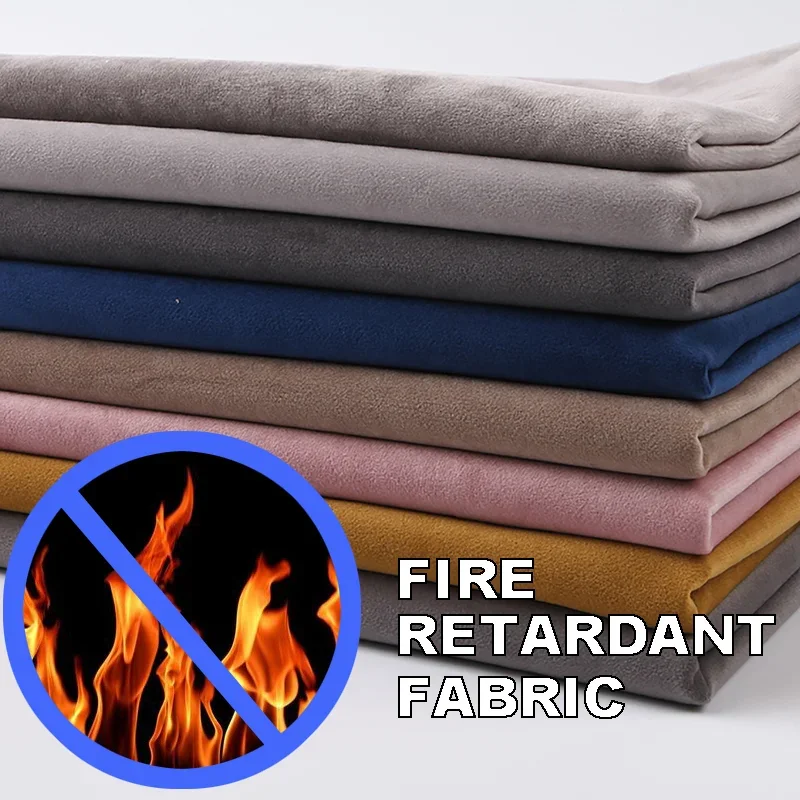Fire safety is of paramount importance in any setting, particularly in environments where large numbers of people gather or where flammable materials are present. In such cases, fire retardant materials are crucial to minimize the risk of fire-related accidents. Fire retardant blackout upholstery fabric is specifically designed to provide both fire resistance and light-blocking properties. In this article, we will delve into the properties of fire retardant blackout upholstery fabric, exploring its composition, characteristics, and applications.
Composition and Manufacturing
Fire retardant blackout upholstery fabric is typically made from a combination of synthetic fibers, such as polyester or nylon, and fire retardant additives. These additives are incorporated during the manufacturing process to enhance the fabric's fire resistance properties. The specific composition may vary depending on the manufacturer and the desired level of fire retardancy.
The manufacturing process of fire retardant blackout upholstery fabric involves several steps. Initially, the synthetic fibers and fire retardant additives are blended together to create a homogeneous mixture. This mixture is then spun into yarns, which are woven or knitted into the desired fabric structure. The fabric is then treated with fire retardant chemicals to enhance its fire resistance properties. The final step involves applying a blackout coating to the fabric to block out light.

Properties of Fire Retardant Blackout Upholstery Fabric
Fire Resistance
The primary property of fire retardant blackout upholstery fabric is its ability to resist or slow down the spread of fire. The fire retardant additives present in the fabric work by interrupting the combustion process and reducing the fabric's flammability. This helps prevent the rapid spread of flames, giving occupants of the space more time to evacuate and reducing the risk of severe property damage.
Fire retardant blackout upholstery fabric is often subjected to rigorous testing to ensure compliance with industry standards and regulations. It is important to note that different fabrics may have varying levels of fire resistance, depending on the specific fire retardant additives used and the construction of the fabric.
Light Blocking
Another significant property of fire retardant blackout upholstery fabric is its ability to block out light. The blackout coating applied to the fabric prevents the transmission of light, making it an ideal choice for spaces where complete darkness is required, such as theaters, cinemas, or bedrooms.
The light-blocking feature of fire retardant blackout upholstery fabric not only enhances privacy but also contributes to energy efficiency. By blocking out sunlight, the fabric helps to regulate indoor temperatures, reducing the need for excessive air conditioning or heating. This can result in energy savings and a more comfortable environment.
Durability and Easy Maintenance
Fire retardant blackout upholstery fabric is designed to be durable and long-lasting. The synthetic fibers used in its composition are known for their strength and resilience, allowing the fabric to withstand regular use and maintain its integrity over time. This durability is particularly important when considering upholstery applications, where the fabric may be subjected to frequent contact and abrasion.
Additionally, fire retardant blackout upholstery fabric is typically easy to clean and maintain. Most fabrics can be spot cleaned with mild detergents or professionally cleaned to remove stains and maintain their appearance. It is important to follow the manufacturer's recommended cleaning instructions to ensure the fabric's fire retardant properties are not compromised during the cleaning process.
Applications of Fire Retardant Blackout Upholstery Fabric
Fire retardant blackout upholstery fabric finds a wide range of applications in various industries. Some common applications include:
Commercial Spaces: Fire retardant blackout upholstery fabric is commonly used in commercial spaces, such as theaters, auditoriums, hotels, and restaurants. Its fire resistance and light-blocking properties make it essential for creating safe and comfortable environments for patrons.
Residential Use: In residential settings, fire retardant blackout upholstery fabric is popular for use in bedrooms, particularly for curtains, drapes, or blinds. Its ability to block out light ensures privacy and promotes better sleep.
Healthcare Facilities: Fire retardant blackout upholstery fabric is also utilized in healthcare facilities, including hospitals and clinics. Its fire resistance properties provide an added layer of safety, especially in areas where flammable substances are present. The light-blocking feature also contributes to patient comfort and promotes a restful environment.
Public Transportation: Fire retardant blackout upholstery fabric is often employed in the transportation industry, such as in trains, buses, and airplanes. Its fire resistance properties help reduce the risk of fire-related incidents and enhance passenger safety.

Conclusion
Fire retardant blackout upholstery fabric offers a combination of fire resistance and light-blocking properties, making it an essential choice for various applications. Its ability to slow down the spread of fire and block out light contributes to the safety, privacy, and comfort of spaces. The durability and easy maintenance of the fabric further enhance its value.
When selecting fire retardant blackout upholstery fabric, it is important to consider the specific fire resistance requirements and standards applicable to the intended application. Adhering to industry regulations and working with reputable manufacturers ensures the fabric's reliability and suitability for its intended use.
Wejoy Trade focuses on the production of furniture hardware accessories. If you need custom Nepali velvet fabric or order wholesale, welcome to contact us.
Email: jay@wejoytrade.com
